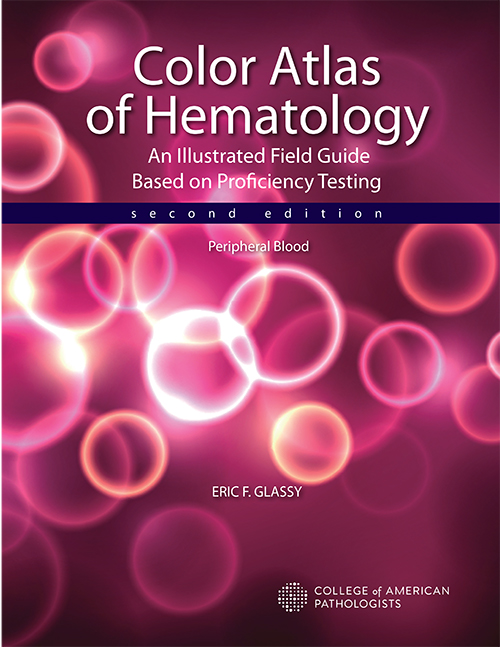January 2024—Thrombophilia testing has been shown to be performed far more often than indicated in thromboembolic events, at significant cost to the patient and hospital.
Read More »Panelists on viscoelastic and other coag assays
January 2024—Viscoelastic assays and other coagulation tests were front and center when CAP TODAY publisher Bob McGonnagle on Nov. 20 convened seven people in an online roundtable. Oksana Volod, MD, and Eric Salazar, MD, PhD, and five company representatives weighed in on, among other things, appropriate test use, automation, and laboratory-developed tests. What they said begins here.
Read More »And the band neutrophil counts play on
December 2023—The recent CAP proficiency testing questionnaire was meant to be the coup de grâce. Hematology PT participants were asked about their band neutrophil reporting practices and, given that these manually generated counts were supposedly on their way out decades ago, the authors of the survey questionnaire expected to see very little activity. The survey, they hoped, would be a way to pound the final, data-driven nail in the coffin. Or, as lead author Maria (Ria) Vergara-Lluri, MD, puts it, “We thought this had all been laid to rest 30 years ago.” It wasn’t. Says Dr. Vergara-Lluri: “Surprise: 86 percent of labs that participated still report bands.” The results of the survey upended many of the assumptions, if not hopes, the authors might have had. Among laboratories that reported manual differentials, they found that most reported bands (4,554 of 5,268). Moreover, only 73 percent reported band reference ranges. On the morphologic challenge, bands classified as “easy” were indeed easy—participants classified them well.
Read More »New guidance on lab analysis in diabetes
December 2023—The third and latest edition of recommendations for laboratory analysis in diagnosing and managing diabetes mellitus, released this summer, provide guidance on, among other things, ketone testing, glycolysis, and point-of-care testing. The last such recommendations were published in 2011.
Read More »Phlebotomy program gives lift to lab, community
December 2023—The clinical laboratory at Children’s Hospital of Philadelphia is solving two problems at once: its phlebotomist staffing shortage and the need for some in its community to learn a new skill and obtain employment.
Read More »In some settings, alternatives to HbA1c acceptable
November 2023—Glycated albumin and fructosamine are highly specific, with high levels suggesting hyperglycemia. This points to their utility in monitoring glycemic control in people with diabetes. “They’re quite useful in the setting of overt hyperglycemia,” said Elizabeth Selvin, PhD, MPH, at this year’s meeting of the Association for Diagnostics and Laboratory Medicine.
Read More »New guide to whole blood viscoelastic assays: hemostasis, testing, cases, and applications
October 2023—New this month from CAP Publications is Whole Blood Viscoelastic Assays in Clinical Diagnosis: An Illustrated Case-Based Guide. Viscoelastic testing was designed to determine the cause of intraoperative or trauma-related bleeding to guide hemostatic therapy. CAP TODAY asked the book’s editor, Oksana Volod, MD, about the guide. See her answers and a sample chapter. Dr. Volod is professor of pathology and director of the coagulation consultative service, Cedars-Sinai Medical Center, Los Angeles.
Read More »New viscoelastic testing requirement in checklist
September 2023—A proficiency testing accreditation requirement in the new checklist edition was revised to add clarification, and a new requirement on viscoelastic testing will close an existing gap.
Read More »The human gut microbiome and blood biochemistry connection
July 2023—The human microbiome has been called the forgotten organ, and at one time it was. But not in the past 10 years. James Versalovic, MD, PhD, made that clear in his talk at the Association for Molecular Pathology meeting last year.
Read More »For sepsis Dx, MDW biomarker brought into the mix
July 2023—When Butler Health System in early 2020 installed the Beckman Coulter DxA 5000 automation line, its hospitals were among the first in the country to do so. At the same time, Butler went live with the DxH 900 hematology analyzer.
Read More »‘Hundreds of variants’—Staying alert to HbA1c method interference
May 2023—Of the five methods used to measure HbA1c—immunoassay, boronate affinity, enzymatic, capillary electrophoresis, and ion-exchange HPLC—only the latter two can alert the laboratory and physician to the presence of a suspected hemoglobin variant. Even so, there are reasons to be cautious.
Read More »New paths through hematologic neoplasms
March 2023—Updated classifications for hematologic neoplasms are here. Let the complications continue. As with other specialties, hematopathology has been absorbing advances gleaned from molecular and genetic data. In some cases, this can tilt diagnosis away from primarily immunophenotypic approaches. It might lead to splits in what was formerly a single entity. On occasion, it might suggest further testing options that could be of value to patients now, or possibly at a date down the road. Or it might just leave pathologists and their clinical colleagues peering at a lack of data, knowing they have to make decisions nonetheless. Two groups—the World Health Organization and the International Consensus Classification—have put forth classifications to help physicians sort through the complexities. The WHO published a beta version of the fifth edition of its Classification of Haematolymphoid Tumours in July 2022.
Read More »Case review reveals latest on overtransfusion
March 2023—A retrospective study of patients who received blood transfusions at 15 community hospitals found that just over half of the patient encounters reviewed could have been managed without the transfusion of at least one component type, and 45 percent could have been managed without any transfusion.
Read More »For those who want it easy, blood draws anywhere
March 2023—The need was always there for some. For others, it’s a matter of convenience. “Home phlebotomy as a concierge service” is how Michael Eller describes what went live in 2019 in New York at Northwell Health, where he is assistant vice president of business development for its laboratories. “It was just a matter of using the capacity we already had in the field and hiring appropriately as needed,” he says.
Read More »Ins and outs of von Willebrand factor activity assays
January 2023—Guidelines for the diagnosis of von Willebrand disease, published in 2021, have raised questions about which von Willebrand factor activity assay laboratories should use.
Read More »For blood cultures, a lab’s new system and incubation time
January 2023—For the central microbiology laboratory serving Barnes-Jewish and four other hospitals in the St. Louis area, validating and implementing a new blood culture system and moving to a shorter incubation time came at a perfect time: right before the pandemic.
Read More »Volume? Space? Automation decisions in coagulation
January 2023—Automation and point-of-care, reflex, and viscoelastic testing were some of what came up when a group spoke with CAP TODAY publisher Bob McGonnagle in late November about hemostasis testing. Also tossed in: Results reporting to the EHR, which “can always be improved,” said Eric Salazar, MD, PhD, of University of Texas Health San Antonio. And D-dimer, one of the pandemic’s “health care heroes,” said Nichole Howard of Diagnostica Stago. Here’s what they said about all that and more.
Read More »Bright prognosis for brain injury biomarkers
November 2022—The lack of tools for assessing traumatic brain injury has long bedeviled physicians. There’s CT. And then? “This has been an unmet medical need for years,” says Ramon Diaz-Arrastia, MD, PhD, the John McCrea Dickson, MD, professor of neurology and director of the Clinical Traumatic Brain Injury Research Center, University of Pennsylvania Perelman School of Medicine. “As many of us know, it’s one of the major barriers that has hindered clinically advanced development of new therapies in TBI. And I think it’s pretty clear that the clinical evaluation alone leaves a lot to be desired.” “I am always frustrated that we have limited tools,” agrees Frederick Korley, MD, PhD, associate professor and associate chair for research in emergency medicine, University of Michigan Medical School, and scientific director, Massey TBI Grand Challenge, Weil Institute, University of Michigan. That’s now on the cusp of changing. Blood-based biomarkers for brain injury may not be bellying up to the bar just yet, but they are starting to raise the bar for how physicians assess TBI.
Read More »The art and science of positive blood cultures
October 2022—It might be possible to tot up, using only the number of toes on an ordinary foot, how many labs are feeling full of vim and vigor these days, open to concepts like creative destruction and get those creative juices flowing and have fun with it—slogans once easily uttered but now tiring to enact. Nevertheless, Margie Morgan, PhD, D(ABMM), would like her colleagues to at least consider the possibility of inspiration in the microbiology laboratory. In particular, Dr. Morgan, medical director of microbiology and professor of pathology and laboratory medicine, Cedars-Sinai Medical Center, Los Angeles, has some thoughts about using a new automated system to facilitate rapid microbial identification from positive blood cultures. The Arc system, from Accelerate Diagnostics, is composed of the Arc module and blood culture kit and concentrates organisms recovered in positive blood cultures for direct testing on MALDI-TOF mass spectrometry. Dr. Morgan and colleagues have been using the system since February.
Read More »Platelet transfusions: safety, cost, and workflow
October 2022—The jury may no longer be out on whether pathogen reduction of platelet units reduces the risk of a septic transfusion reaction enough to replace culturing of platelet units.
Read More »Enabling ‘the magic’ in hematology—eyes on what labs need
October 2022—New and better solutions for the hematology laboratory. That was at the center of a Sept. 2 virtual roundtable, led by CAP TODAY publisher Bob McGonnagle. With him were Jonathan Galeotti, MD, of the University of North Carolina School of Medicine, and representatives of Sysmex America, Siemens Healthineers, Beckman Coulter, and CellaVision. “It’s a new era in terms of what can happen in hematological data,” said Fernando Chaves, MD, global head of hematology, Siemens Healthineers.
Read More »As blood supply tightens, so too does mitigation
September 2022—Picture a performer juggling tenpins while walking a high wire, knowing that a hurricane looms. Add a safety net that could disappear at any time. That’s a sense of what hospital transfusion services experience in maintaining enough blood products to meet patients’ needs.
Read More »U.S. blood supply steadier but still short
August 2022—Blood is a precious resource and shouldn’t be treated as a commodity. That’s the consensus in the blood banking community, in line with a longstanding conviction that volunteer donations should remain at the blood system’s core. But as the worst of the pandemic appears to have passed, discussion of blood shortages has increasingly drawn on the vocabulary of commerce, and the warnings about the blood supply have been rife with references to supply chain problems that go beyond the need for more donations. Crises in the blood supply are nothing new, and while the health care system strives to stay prepared, the pandemic threw novel commercial and logistical factors into the mix, in some ways jumbling the expected order of a crisis for blood services. Hospitals scrambled to cope with a surge of COVID-19 patients while the spread of infection caused thousands of blood drives to be canceled, so there was a steep drop in supply of blood products, says Pampee Young, MD, PhD, chief medical officer, biomedical services, American Red Cross.
Read More »Transgender care, in and beyond the lab
July 2022—Gabrielle Winston-McPherson, PhD, could be talking about almost any aspect of laboratory medicine as she recounts how the Henry Ford Health chemistry division, in which she is associate director, has identified a patient care need. She talks about the desire to improve health outcomes. Identifying problems in the preanalytical process. Appropriate test utilization. Putting together a team to develop training material. Assembling data and information prior to implementation. Informatics challenges. And, naturally, the perpetual financial concern of ensuring allocation of limited resources. How else would she—or any other laboratory professional—talk about the lab’s role in transgender health care? In fact, there are many other ways to discuss the topic. “It’s been in the news a lot these days, obviously,” says Matthew Krasowski, MD, PhD, clinical professor and vice chair, clinical pathology and laboratory services, University of Iowa Hospital and Clinics. In fact, there are many other ways to discuss the topic.
Read More »Monoclonal gammopathies: which tests and why
July 2022—Variability in testing for monoclonal immunoglobulin proteins was in part what led to the new guideline on laboratory detection and initial diagnosis of monoclonal gammopathies, published in May.
Read More »One hospital’s story: Ins and outs of low titer O whole blood use in trauma
July 2022—Myriad questions had to be answered and plans made to put low titer O whole blood in the trauma bay at Thomas Jefferson University Hospital. Julie Katz Karp, MD, associate professor and director of transfusion medicine, reported why, when, and how it was done and where they stand today, in a process she describes as “a never-ending series of hoops.”
Read More »Lining up for low titer O whole blood in trauma care
June 2022—For many blood suppliers, there is more enthusiasm for low titer O whole blood than there is an ability to make it, especially with the pandemic having made it harder than ever to collect.
Read More »Integrating NGS into the cytopenia workup
May 2022—Myelodysplastic syndromes are often challenging to diagnose, and it’s the exceptions to the rules that make it so, said Phillipp W. Raess, MD, PhD, associate professor of pathology and laboratory medicine, Oregon Health and Science University, speaking at CAP21.
Read More »The impact of diagnostics on antimicrobial decisions
April 2022—A study published last fall examined antimicrobial prescribing in gram-negative bloodstream infections based on three rapid diagnostic panels and using what’s known as the DOOR-MAT framework. The study’s findings were explained in a CAP TODAY webinar on stewardship interventions to optimize the management of gram-negative bacteremia. It was presented last December and made possible by a special educational grant from BioFire.
AMP case report: ETV6/FLT3 fusion gene detected in a patient with T-cell lymphoblastic lymphoma
April 2022—Genetic alterations of the gene FLT3, especially internal tandem duplications in the juxtamembrane domain and point mutations in the tyrosine kinase domain, are commonly seen in patients with newly diagnosed myeloid leukemias. However, chromosome rearrangements involving the FLT3 gene are extremely rare in hematologic malignancies. The FLT3 gene has only a few known partner genes, including the gene ETV6, which encodes a transcriptional repressor. ETV6 has a wide variety of translocation partner genes, several of which are tyrosine kinase genes.
Steps to preventing coag test processing error
February 2022—It was Isaac Asimov who surmised: “The most exciting phrase to hear in science is not ‘Eureka!’ but ‘That’s funny . . .’” And it was coagulation processing in the clinical laboratory that, in a small way, illustrated Asimov’s axiom for Dorothy Adcock, MD, former chief medical officer, Labcorp Diagnostics.
Read More »Measuring direct oral anticoagulants—when, how
January 2022—Laboratories don’t have to monitor direct oral anticoagulants, but they might want to measure DOAC drug levels in some situations in some patients, said Karen A. Moser, MD, in a CAP21 session.
Read More »Up close on clonal hematopoiesis in cfDNA testing
October 2021—Clonal hematopoiesis is a significant biological phenomenon and denotes presence of mutations in bone marrow stem cells in the absence of a hematologic malignancy.
Read More »Panel weighs in on practices, pressures in heme labs
October 2021—Rules, slide reviews, test ordering, and provider education were part of the conversation when CAP TODAY publisher Bob McGonnagle convened a hematology-focused virtual roundtable in late August. Workforce problems too: “We have a bigger exodus now and our pipeline is smaller,” said Eric D. Hsi, MD, of Wake Forest University.
Read More »In coag collections, every detail counts
September 2021—Rare wine? Delectable. Rara avis? Magnificent. Rare blue-top collection tube? Uh oh. For Richard Marlar, PhD, coming across a non-FDA-approved tube was an unhappy discovery. Dr. Marlar, medical director, coagulation laboratory, University of New Mexico Hospital, says his lab was among the first to encounter one of these rogue tubes, available for purchase on the internet and likely taking wing due to pandemic supply shortages. When the tube arrived for testing, it quickly kindled concerns, says Dr. Marlar. “It’s a tube we had never seen before. It looks like it has a CE mark on it, and the Europeans don’t know anything about it. It has a label on it that suggests it’s FDA approved—but the FDA is not aware of it,” he says, adding that his lab has spoken with the agency. It feels like a “CSI”-tinged moment in a venue that labs would prefer to keep drama-free. It also points to the ongoing need to keep a keen eye on what passes through coagulation laboratories. It’s not so much that the devil is in the details; rather, that’s where accurate results lie.
Read More »Testing for platelet function using whole blood
August 2021—Platelet function testing using platelet-rich plasma is the gold standard, but whole blood platelet aggregation has its advantages, with less risk for preanalytic error among them.
Read More »Coag issues occupy COVID’s central stage
July 2021—The pandemic’s reach has often been portrayed in shades of red, signaling surging COVID-19 cases across states and countries. Vaccination maps, on the other hand, tend to render progress in more soothing tones, typically in the green family. But in coagulation laboratories, one small portent is colored blue—specifically, blue-top sodium citrate tubes. In recent months, laboratories began voicing concerns about tightening supplies. They’ve spoken with their vendors; some have reached out to new ones. And though no one wants to think about limiting testing if supplies truly become scarce, it wouldn’t be the first time labs have had to steer through these waters. The tubes are a functional symbol of the continued complexities of COVID-19-related coagulopathy, as physicians try to understand and respond to the pathophysiology of infection that leads to a thrombotic event. As the pandemic has churned on, much has started coming into sharper focus. Prepublication persists, but physicians have begun to sort through the past 18 months and, as many have put it, to “do the science.”
Read More »Testing for platelet function using platelet-rich plasma
July 2021—Identifying severe disorders of primary hemostasis is relatively straightforward for most coagulation laboratories, but the more prevalent disorders with less severe bleeding and less overt diagnostic abnormalities are trickier, and platelet function testing using platelet-rich plasma remains the gold standard. Geoffrey Wool, MD, PhD, in an AACC virtual session last year, presented some of his laboratory’s cases to illustrate the use of light transmission aggregometry and a modification called lumi-aggregation.
Read More »Higher stakes in systemic mastocytosis
June 2021—Mastocytosis is not for quitters. Not at any point, from considering the possible diagnosis, to doing a complement of stains, to looking for mutations beyond KIT D816V, to being curious about the presence of mast cells even after making a diagnosis of another myeloid disease. Patients have already learned this grueling lesson. They can easily spend years seeking answers before their disease is properly identified. Pathologists can speed up that process—and the time to do so is now, says Tracy George, MD, chief medical officer and incoming president of ARUP Laboratories, and medical director of hematopathology. Notes Dr. George: “There’s some exciting stuff going on with systemic mastocytosis.” New targeted KIT inhibitors appear to be quite effective, including at least one agent for advanced systemic mastocytosis that has been submitted to the Food and Drug Administration. “We anticipate there’s going to be approval by the FDA this summer,” says Dr. George, who’s been involved in the clinical trials for avapritinib (Blueprint Medicines).
Read More »Puzzling out platelet function disorders
June 2021—In an AACC virtual session last December, Catherine P. M. Hayward, MD, PhD, of McMaster University, set out the stepwise approach to testing for platelet function disorders, explained the methods used to assess platelet aggregation response, and reported what most clinical labs do.
Read More »B- and T-cell neoplasm features and fine points
June 2021—A case of monoclonal B-cell lymphocytosis and a tour of B- and T-cell morphologies were at the heart of a CAP20 virtual presentation on neoplastic lymphocytosis. Kyle Bradley, MD, associate professor of hematopathology and director of surgical pathology at Emory University, spoke last fall on reactive (CAP TODAY, May 2021) and neoplastic lymphocytosis, with Olga Pozdnyakova, MD, PhD, who addressed neutrophilia and monocytosis (CAP TODAY, February and March 2021). Together they took attendees through a morphology-based approach to hematopoietic neoplasms presenting with an abnormal WBC differential.
Read More »Lymphocytosis: distinguishing benign from malignant
May 2021—How to distinguish “reactive” and “nonreactive” benign lymphocytosis from malignant lymphocytosis, and between benign and malignant large granular lymphocytosis, is how Kyle Bradley, MD, of Emory University, opened his talk in a CAP20 virtual session last fall.
Read More »Resistance targets: blood culture ID panel pitfalls
May 2021—Most of the time, bloodstream infection antimicrobial resistance results achieved with blood culture molecular ID panels will be accurate. When and why they might not be was the focus of an AMP 2020 virtual session. “I don’t want to lead anyone to believe that these are not good, accurate, and important types of tests,” Richard E. Davis, PhD, D(ABMM), MLS(ASCP)CM, said of the panels.
Read More »‘Know your panel’: Blood culture ID cautions
April 2021—The interpretive challenges of blood culture identification panels were the focus of an AMP2020 virtual presentation on false-positives and false-negatives and their sources and solutions.
Read More »Close-up on abnormal monocyte morphology in peripheral blood smears
March 2021—A recently published study of 90 patients found significant numeric and atypical white blood cell morphologic changes associated with SARS-CoV-2 infection that differed between mild and severe disease.
Read More »Vascular changes in lung—a piece of the puzzle
March 2021—If you see vascular changes, report them. That is the advice Kristen L. Veraldi, MD, PhD, pulmonary critical care physician, University of Pittsburgh Simmons Center for Interstitial Lung Disease, gave last fall in a CAP20 virtual session on vascular changes in lung biopsies—when and what to report.
Read More »Rapid ID from positive blood culture: Labs tally gains
March 2021—Fresh from its Dec. 27, 2020 FDA clearance, the Bruker MALDI Sepsityper Kit US IVD promises to provide microbiology laboratories with a universal, rapid sepsis identification solution. With the Bruker MALDI Biotyper platform’s reference library covering 491 organisms, the Sepsityper’s ability to identify pathogens directly from positive blood cultures in suspected bacterial or fungal sepsis cases delivers an “order of magnitude increase” in the number of microorganisms that can be identified through PCR detection, said Wolfgang Pusch, Bruker Daltonics executive vice president of microbiology and diagnostics, in a company statement.
Read More »Finding the morphologic clues to neutrophilia etiology
February 2021—Granulocyte morphology may contain clues to neutrophilia etiology, and that was the focus of a CAP20 virtual presentation by Olga Pozdnyakova, MD, PhD, associate professor of pathology at Harvard Medical School and medical director of the hematology laboratory at Brigham and Women’s Hospital. Reactive changes can mimic myeloproliferative neoplasm, but myeloproliferative neoplasm can have reactive morphology, she said. Pathologists can piece together clinical and morphological clues, “especially in concert with the clinical team, that may help them decide whether the changes are more reactive or more neoplastic in nature,” she told CAP TODAY in a follow-up interview. Neutrophilia is defined as greater than 7.7 × 109/L or two standard deviations above the mean, and it is important to note whether it is present in the context of the left shift.
Read More »Coagulation tests and COVID: inside labs, industry
January 2021—COVID-19 and coagulation testing were up for discussion on Nov. 20 when six people joined CAP TODAY publisher Bob McGonnagle to talk about that and laboratory labor, relationships with industry and hospital administration, and the distribution of testing. “We’re working with all the manufacturers to support rapid point-of-care testing to manage hot spots that will pop up once there is a vaccine,” said Orchard Software’s Curt Johnson. With Johnson and McGonnagle on the call were Oksana Volod, MD, of Cedars-Sinai Medical Center; Neil Harris, MBChB, MD, of the University of Florida; Annie Winkler, MD, MSc, of Instrumentation Laboratory; Nichole Howard, MBA, of Diagnostica Stago; and Jason Lam, MBA, MLS, of Siemens Healthineers. Drs. Volod and Harris are members of the CAP Hemostasis and Thrombosis Committee.
Read More »Digging into drug’s effect on aPTT-based assays
December 2020—As ongoing studies reveal the merits of emicizumab for hemophilia A patients—fewer bleeding episodes, longer duration between treatments—laboratories need to be alert to the drug’s effect on coagulation testing.
Read More »A walk-through on 2 curbside consults
February 2020—In vivo hemolysis accounts for less than two percent of cases of hemolysis, but don’t assume all hemolysis is in vitro. That was the point of one of the patient cases presented at CAP19 in a session on curbside consults in clinical pathology.
Read More »D-dimer trifecta: clarity on units, values, and use
January 2020—D-dimer has a problem. Several problems, in fact. Many, some might say. Let’s start with the basics regarding D-dimer assays: unit and magnitude. Setting up the equation is easy, and the digits are small: 2 × 4. When applied to D-dimer testing, however, the answer often means far-flung problems for laboratories and clinicians. Parsed out (for fans of James Thurber, this means channeling schoolmarm Miss Groby), D-dimer has two different units of measure. Some assays report fibrinogen equivalent units (FEU), and others measure D-dimer units (DDU).
Read More »HemoCell workcell approach brings efficiencies to coag
November 2019—Total laboratory automation solutions, with their integrated, comprehensive approach, have meshed well with the goals of many central labs. But with HemoCell, the first lab automation solution designed for hemostasis testing, Instrumentation Laboratory has shifted gears toward a more specialized solution: a workcell to improve quality and efficiency through process standardization. IL’s HemoCell integrates the company’s ACL Top 750 LAS testing systems, HemoHub Intelligent Data Manager, and HemosIL reagents with Thermo Fisher Scientific’s TCAutomation track. The company’s initial customer base for HemoCell has been in Europe, Asia (particularly China), and South America. Now IL hopes to bring the benefits of HemoCell to more U.S. labs.
Read More »Hemostasis testing: What is the impact of direct oral anticoagulants?
July 2019—Prevention and treatment of venous thromboembolic disease is accomplished through the use of anticoagulant agents, which are prescribed for millions of Americans annually. A revolution in anticoagulant use has occurred over the last decade, as direct oral anticoagulants (DOACs) were introduced to the market. The new agents have a number of advantages over warfarin, the traditionally administered oral agent, which is a vitamin K antagonist (VKA).
Read More »Peripheral blood evaluation: B12 deficiency, anemia, ET, CMML
April 2019—Diagnoses of essential thrombocythemia and chronic myelomonocytic leukemia were among those covered in four cases in a CAP18 session on practical challenges in peripheral blood evaluation.
Read More »Practical challenges in peripheral blood smear evaluation
March 2019—Unlike high-count monoclonal B-cell lymphocytosis, low-count MBL has a limited chance of progression to CLL and thus there is no need for follow-up. And a definitive diagnosis of T-cell large granulocytic leukemia requires demonstration of clonality.
Read More »Navigating the quandaries of coagulation testing
January 2019—Naming the things about coagulation testing that most perplex clinicians isn’t easy for Michael Laposata, MD, PhD. But there’s a good reason for that: He finds confusion to be pervasive.
Read More »Hematology roundtable: rules, reference ranges, POC testing
November 2018—Reference intervals, point-of-care testing, the use of rules for efficiency, and the display of results in patient records. That and more is what a panel of experts weighed in on when CAP TODAY publisher Bob McGonnagle assembled them in September to talk about hematology instrumentation. What they told us follows.
Read More »Hemophilia drug interferes with APTT-based assays
September 2018—When a miracle drug comes along that is predicted to cause havoc in the laboratory, the drug could well seem like a double-edged sword. In the case of emicizumab (Genentech’s Hemlibra), for patients with hemophilia A, the mix of both benefits and drawbacks is likely to settle in for the long term.
Read More »Direct oral anticoagulants and APTT, PT results: The risk of normal results in patients on therapy
July 2018—With the introduction of direct oral anticoagulants (DOAC) there is a paradigm shift in the use and understanding of screening coagulation tests to determine a patient’s bleeding risk. In patients on DOAC therapy, clinicians cannot rely on normal activated partial thromboplastin time (APTT) and prothrombin time (PT) results to reflect the patient’s level of anticoagulation.
Read More »New Color Atlas of Hematology to be used ‘in the wild’
January 2018—New this month from CAP Press is the second edition of the Color Atlas of Hematology: An Illustrated Field Guide Based on Proficiency Testing. “More and better are the watchwords,” senior editor Eric F. Glassy, MD, told CAP TODAY when we asked what the reader can expect. David Blomberg, MD, and Katherine Galagan, MD, are associate editors.
Read More »In hemostasis, two hot-button testing issues
December 2017—Having validation data to support the use of age-adjusted D-dimer cutoffs with the D-dimer assay your laboratory uses is a must, and know well the limitations of point-of-care prothrombin time/INR testing. That advice and more was shared in a “Hot Topics in Hemostasis” session at CAP17, presented by Russell Higgins, MD, and Karen Moser, MD.
Read More »Life-threatening bleeding—what’s the right call?
June 2017—In the CAP16 session, “Your Turn: Management of the Bleeding Patient,” Theresa Nester, MD, reminded attendees who provide transfusion medicine consultation to assess the available information before calling the clinical team: patient history, drugs, coagulation test results, and products administered so far. “Your main role is to help determine why the patient is bleeding and the most appropriate treatment,” said Dr. Nester, medical director of integrated transfusion services at Bloodworks Northwest in Seattle.
Read More »Emergency hemorrhage panel gives surgeons what they need
June 2017—As an alternative to point-of-care testing, Wayne Chandler, MD, and colleagues developed and implemented a rapid emergency hemorrhage panel, or EHP, for trauma patients (Chandler WL, et al. Transfusion. 2010;50[12]:2547–2552). The panel tests are prothrombin time, hematocrit, fibrinogen, and platelet count. “By limiting EHPs to patients that were actively bleeding, EHPs accounted for only 8 of 243 coagulation samples per day,” he and colleagues wrote in their 2010 article.
Read More »Hemophilia management: Tips on monitoring modified replacement therapies
April 2017—Some modified recombinant factor VIII and IX products for hemophilia prophylaxis show significant reagent-dependent recovery in the one-stage assay, while recovery in the chromogenic assay appears to be more consistent, especially for modified recombinant factor IX. The variable results can lead to over- or underestimating the factor level, warn Stefan Tiefenbacher, PhD, of Colorado Coagulation, and Rajiv K. Pruthi, MBBS, of Mayo Clinic.
Read More »Lower HbA1c seen with sickle trait, but questions remain
March 2017—Perhaps unusually for news about clinical diagnostics research, an article in the Feb. 7 issue of JAMA created a mild stir with findings that HbA1c results in patients with sickle cell trait, the most common hemoglobin variant in the U.S., may systematically underestimate past glycemia (Lacy ME, et al. 317[5]:507–515).
Read More »Hemophilia diagnosis: how to test, what to know
March 2017—True, hemophilia is no longer commonly known as the “royal disease” (as it was when several generations of European rulers suffered from it). But in a January webinar, Dorothy M. Adcock, MD, gave some royally important suggestions regarding the laboratory diagnosis of hemophilia A and B.
Read More »Hemostasis testing guide now out in new edition
June 2016—The older we get, the faster time seems to pass. That’s why 2008 might not feel like all that long ago—until you consider that Obama had yet to take office, Donald Trump’s television appearances were limited largely to The Apprentice, and there was no “like” button on Facebook.
Read More »Pressing questions in POC glucose testing
April 2015—Sometimes major changes to a health care organization’s point-of-care testing system come from powerful regulatory agencies in Washington, DC. Or they may arise when a child with diabetes objects to frequent venipuncture. In either kind of case, experts say, pathologists and laboratory professionals must form strong relationships with clinicians and build structural foundations to help them meet these and other demands.
Read More »Nothing peripheral about assessing the ‘other’ cytopenias
April 2015—Think age is important only if you’re a Hollywood actress (unless you’re lucky enough to be Meryl Streep)? Think again. Specifically, Joan Etzell, MD, wants pathologists to think about age-adjusted reference ranges for thrombocytopenia and neutropenia. They’re intrinsic to the basic definitions of these diseases, she pointed out in a course on peripheral cytopenias at last year’s AACC meeting.
Read More »Study, strategy lift up POC critical value practices
February 2015—Too many point-of-care glucose test results in the critical high and low ranges may be nonreproducible and therefore should be repeated. That was the finding of a study published last year that said POC glucose results in the critical ranges should be considered to have a relatively high probability of signaling a potential preanalytic error.
Read More »Diagnostic perils of hematologic illness
February 2015—Like a modern-day Pericles, Tracy George, MD, had much to traverse in her overview of leukocytosis, thrombocytosis, and erythrocytosis during a course on diagnostic hematology at last year’s AACC meeting. Unlike Shakespeare’s Pericles, however, Dr. George navigated the many twists of her topic with the efficiency and near-encyclopedic knowledge of an experienced tour guide.
Read More »Coag quest: keying into the clot risk of cancer patients
January 2015—It’s a somewhat stark fact: When hospitalized cancer patients die from something other than cancer, the cause is most likely to be venous thromboembolism. But there is a degree of mystery about why some cancer patients are more prone than others to be afflicted with VTE.
Read More »Anemia: classification challenge and clinical questions
December 2014—Anemia is in the eye of the classifier. While that’s not as elegant as the “beauty-beholder” saying, it’s much more important. To be able to effectively treat and diagnose anemia, “You have to know what is causing the decrease in red cells,” said Sherrie Perkins, MD, PhD, speaking at an AACC workshop this year. There are plenty of definitions to choose from, said Dr. Perkins, of the University of Utah/ARUP Laboratories, Salt Lake City. At the most basic level, she noted, anemia is a pathologic condition marked by a reduced capacity of blood to transport and deliver adequate oxygen to tissues. In short, anemia is a manifestation of disease, not a disease itself.
Read More »Hematology lineup gets year-end look
December 2013—They say change is never easy, but Sysmex seems to be making a downright habit of it: “We have replaced almost 80 percent of our portfolio within the past year,” says Alan Burton, the company’s director of IVD product marketing. Coincidentally or not, Sysmex has seen much success in the last 12 months with its introduction of the XN-Series of automated hematology analyzers. “Already there have been well over 500 XN modules installed across North America,” Burton reports.
Read More »Quick on the draw—coagulation tube response
October 2002—As the sensitivity of coagulation testing has increased, the preanalytical phase has been getting more attention as a potential source of error. Variables that have long been known to affect the accuracy of activated partial thromboplastin times are the reagents and instruments used in testing and the delays between acquiring and processing a blood sample.
Read More »Ways to move quickly on bloodstream infection
October 2013—Since 1942, when penicillin was first used to treat infections caused by gram-positive bacteria, many improved and potent beta-lactam antimicrobials have been developed. Yet today, if a patient in an intensive care unit develops a bloodstream infection with Staphylococcus aureus, that person has a one in three chance of dying. High mortality rates apply to many other pathogens that cause bloodstream infections in ICU patients—from one in five for coagulase-negative staphylococci and Escherichia coli to almost 40 percent for Pseudomonas aeruginosa and Candida spp. Enterobacter spp and Enterococcus spp have intermediate mortality rates: one in four and one in three, respectively. Even among patients on a non-ICU ward, bloodstream infections are associated with mortality rates between 20 percent and 30 percent.
Read More »Latest anticoagulants—nuts and bolts for labs
February 2013—The list of anticoagulants has grown in recent years, which means there’s more to know about whether, when, and how to monitor. Last month in CAP TODAY, Michael Laposata, MD, PhD, spoke briefly about the newer drugs and explained how the older ones—warfarin, heparin, and low-molecular-weight heparin—work, and what that means for labs. This month, he returns to the newest of the major anticoagulants.
Read More »Hemolysis—can better processes add up to millions?
February 2013—If anybody is a believer in programs to reduce hemolysis rates in the hospital, it’s Dennis Ernst, MT(ASCP), director of the Center for Phlebotomy Education. Ever since he left the bench 15 years ago, Ernst has been traveling the country with a mission: to show clinical laboratories, nursing departments, hospital administrators, and clinicians that the payoff from high-quality phlebotomy is much greater than they might realize. Despite hemolysis being the No. 1 reason the laboratory rejects blood specimens, hemolysis does not strike randomly, and it’s not inevitable, Ernst emphasizes. “Typically the causes of hemolysis are all behavioral,” he says.
Read More »How anticoags work, and what that means for labs
January 2013—When to monitor and how? These questions were simpler when the list of anticoagulants patients were given was two or three deep—warfarin and unfractionated heparin, and maybe low-molecular-weight heparin. But the number of anticoagulants has grown and so has the complexity. Old and new—Michael Laposata, MD, PhD, covered the major anticoagulants and antiplatelet drugs in a recent AACC webinar and again at the CAP ’12 annual meeting in September. Here, this month, is an edited transcript of what he said in the webinar about warfarin and heparin and briefly about the newer drugs. In the February issue: a close-up look at fondaparinux, bivalirudin, rivaroxaban, dabigatran, lepirudin, and argatroban.
Read More » CAP TODAY Pathology/Laboratory Medicine/Laboratory Management
CAP TODAY Pathology/Laboratory Medicine/Laboratory Management













































